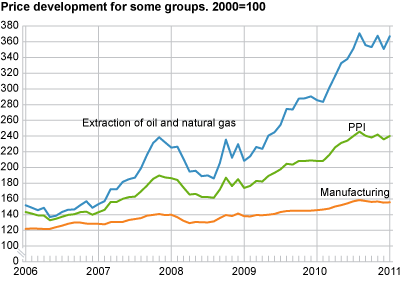Content
Published:
This is an archived release.
Price increases in oil and petroleum products
The producer price index (PPI) increased by 1.8 per cent from August to September, mainly due to higher prices of crude oil, natural gas and petroleum products. Prices of electricity and basic metals fell in the period.
The increase in the PPI from August to September was due to higher prices in extraction of oil and natural gas as well as higher prices in refined petroleum products, which increased by 4.6 and 2.5 per cent respectively. The price of crude oil (Brent Blend) measured in Norwegian kroner increased by about 5.4 per cent in September; much of the price rise was due to a weaker krone relative to the US dollar (USD). Measured in USD, the oil price increased by 2.3 per cent in this period. Similarly, the rise in prices of petroleum products was reinforced by a higher NOK/USD exchange rate, while the whole price increase in natural gas can be seen as a result of the change in the exchange rate.
Low electricity prices
Electricity, gas and steam industry experienced a price drop in September, which helped to curb the rise in the overall index. Electricity prices fell by 13 per cent from August to September. It was week 37 in particular that had the lowest prices in the last four years, and which pulled the monthly average down. Cheaper electricity in September was largely the result of high filling and high inflow in the water reservoirs.
Falling prices in basic metals
Basic metals was another industry with a significant price drop in September. Both iron and steel and non-ferrous metals, aluminium and nickel in particular, were affected by price falls. Metal prices have fallen since February and decreased 2.5 per cent in September. In the period February to September, the metal prices dropped by about 10 per cent.
Twelve-month change: PPI up 15.3 per cent.
The PPI rose by 15.3 per cent from September 2010 to September 2011. The price increase is primarily linked to higher prises in extraction of oil and natural gas, as well as refined petroleum products, which rose by 28.5 and 28.8 per cent respectively during this period.
Electricity prices, however, were 22.9 per cent lower in September than in the corresponding month last year. The price fall in electricity is mainly connected to a better level in water reservoirs. Prices in basic metals fell by 0.2 per cent and we have to go back to November 2009 to find another negative twelve-month change.
|
September
2011 |
Changes, per cent | ||||||||||||||||||||||||||||||||||||||||||||||||||||||||||||||||||||||||||||||
|---|---|---|---|---|---|---|---|---|---|---|---|---|---|---|---|---|---|---|---|---|---|---|---|---|---|---|---|---|---|---|---|---|---|---|---|---|---|---|---|---|---|---|---|---|---|---|---|---|---|---|---|---|---|---|---|---|---|---|---|---|---|---|---|---|---|---|---|---|---|---|---|---|---|---|---|---|---|---|---|
|
August 2011-
September 2011 |
September 2010-
September 2011 |
||||||||||||||||||||||||||||||||||||||||||||||||||||||||||||||||||||||||||||||
| Total index | 240.1 | 1.8 | 15.3 | ||||||||||||||||||||||||||||||||||||||||||||||||||||||||||||||||||||||||||||
| Extraction of oil and natural gas | 367.0 | 4.6 | 28.5 | ||||||||||||||||||||||||||||||||||||||||||||||||||||||||||||||||||||||||||||
| Manufacturing, mining and quarrying | 155.7 | 0.3 | 6.9 | ||||||||||||||||||||||||||||||||||||||||||||||||||||||||||||||||||||||||||||
| Electricity, gas and steam supply | 230.9 | -13.0 | -22.9 | ||||||||||||||||||||||||||||||||||||||||||||||||||||||||||||||||||||||||||||
| Main industrial groupings | |||||||||||||||||||||||||||||||||||||||||||||||||||||||||||||||||||||||||||||||
| Intermediate goods | 143.0 | -0.6 | 2.0 | ||||||||||||||||||||||||||||||||||||||||||||||||||||||||||||||||||||||||||||
| Investment goods | 127.9 | 0.2 | 1.1 | ||||||||||||||||||||||||||||||||||||||||||||||||||||||||||||||||||||||||||||
| Consumer goods | 133.3 | 0.2 | 5.9 | ||||||||||||||||||||||||||||||||||||||||||||||||||||||||||||||||||||||||||||
| Energy goods | 343.8 | 3.4 | 25.2 | ||||||||||||||||||||||||||||||||||||||||||||||||||||||||||||||||||||||||||||
|
For information on the commodity price index for the industrial sectors, see commodity price index for the industrial sector . |
Additional information
Contact
-
Producer price index
E-mail: produsentpris@ssb.no
tel.: (+47) 21 09 40 00
-
Elisabeth Mælum
E-mail: elisabeth.maelum@ssb.no
tel.: (+47) 97 01 28 49
-
Morten Madshus
E-mail: morten.madshus@ssb.no
tel.: (+47) 40 90 26 94
-
Monika Græsli Engebretsen
E-mail: monika.graesli.engebretsen@ssb.no
tel.: (+47) 40 90 23 71
-
Håvard Georg Jensen
E-mail: havard.jensen@ssb.no
tel.: (+47) 40 90 26 86

